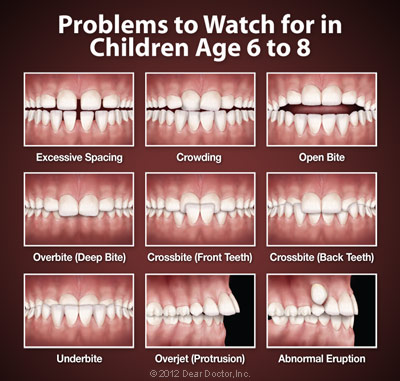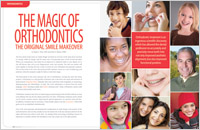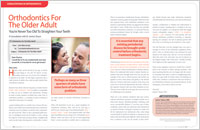What a difference straight teeth can make! A great-looking smile can boost your self-confidence and have a positive impact on social and professional opportunities. Orthodontic treatment is the original smile makeover tool — and you will be happy to know that you're never too old to take advantage of it. But it isn't all about looks: Properly aligned teeth help you to bite, chew and even speak more effectively. They are also easier to clean, which helps keep your mouth free of tooth decay and gum disease.
The amazing thing about orthodontics is that it harnesses the body's natural ability to remodel its own tissue. With the application of light, constant force, orthodontic appliances gently reshape bone and move teeth into better positions. Some examples of these appliances are traditional metal braces, ceramic tooth-colored braces, and clear aligners, a relatively new option for adults and teens.
Bite Problems and How to Fix Them

Orthodontic treatment can resolve a number of bite problems, which often become evident by around age 7. These include underbite, crossbite or excessive overbite, where upper and lower teeth don't close in the proper position; open bite, where a space remains between top and bottom teeth when the jaws are closed; and crowding or excessive spacing, where teeth are spaced too close together or too far apart.
To correct bite problems, teeth need to be moved — but doing that isn't as hard as you might think! Teeth aren't fixed rigidly in their supporting bone; instead, they're held in place by a hammock-like structure called the periodontal ligament, which is very responsive to forces placed on the teeth. Orthodontic appliances move teeth by careful application of light, constant pressure. This force can be applied via metal wires that run through small brackets attached to the teeth (braces), or via the semi-rigid plastic of clear aligners.
Orthodontics is for Children — and Adults
Having orthodontic treatment in childhood is ideal because we can take advantage of a young persons natural growth processes to help move the teeth into proper alignment. Like the rest of the body, the teeth and jaws are changing rapidly. So at this time it's possible (for example) to create more room for teeth in a crowded mouth by using a “palatal expander” to rapidly widen the upper jaw. This phase of growth modification can shorten overall treatment time and ensure the best result if additional orthodontic appliances are needed.
But remember, healthy teeth can be moved at any age, so you've never “missed the boat” for orthodontic treatment. In fact, about one in five of today's orthodontic patients are adults. Several new technological developments — including tooth-colored ceramic braces, clear aligners and invisible lingual braces — have made orthodontic appliances less evident, and enhanced the treatment experience for grown-ups. Before treatment, adults are carefully examined for signs of periodontal (gum) disease, which will be brought under control before treatment begins.
Types of Orthodontic Appliances
When you imagine someone wearing braces, you probably picture small metal brackets bonded to the front of the teeth, with a thin wire running through them. This time-tested style remains very popular — but it's no longer the only option. Clear braces use brackets made of ceramic or plastic which, except for the slim archwire, are hardly visible.
Removable clear aligners are an alternative to fixed orthodontic appliances. They consist of a series of clear plastic “trays” that fit over your teeth exactly; each one moves your teeth a little bit, until they are in the proper position. Whether fixed or removable, each type of appliance may have advantages or disadvantages in particular situations. After a complete examination, we will discuss which treatment options are best for you.
Retention & Post Orthodontic Care
Once your orthodontic treatment is completed, it's extremely important to wear a retainer as directed. That's because teeth naturally tend to drift back to their original locations — which is the last thing you want after you've gone to the trouble of straightening them! Wearing a retainer holds your teeth in their new position long enough for new bone and ligament to re-form around them, and helps keep your gorgeous new smile looking good for a lifetime.
Related Articles

The Magic of Orthodontics
Proper alignment of the teeth is basic to “Smile Design.” Their position dictates how they work together and affects the way you look and smile. Only orthodontic treatment can move teeth into the right position. Simply put, when things look right, they probably are right. Learn the basics of smile analysis and design and whether the magic of orthodontics will work for you... Read Article

Orthodontics for the Older Adult
Healthy teeth can be moved at any age, so there's no such thing as “too old” for braces. In fact, nowadays about one out of every five orthodontic patients is an adult. Yet this figure represents only a small portion of adults who could actually benefit from orthodontic treatment... Read Article

Clear Aligners for Teenagers
Teens who regard traditional braces as restrictive, confining, and obstructive to their lifestyles now have another choice for orthodontic treatment: clear aligners. This advanced dental technology, originally geared toward adults, has recently evolved to treat a greater variety of bite problems in younger people. These improved orthodontic appliances can help teens function normally during a difficult phase of life... Read Article